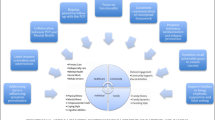Abstract
The experience of a consultant pediatrician is described as he attempts to seek out and manage a “nonpresenting symptom.” In some patients and their families, this thoroughness led to an appreciation of the diagnostic skill of the pediatrician and an acceptance of the recommendations made. In other patients, particularly when the management of the additional diagnoses involved one or more parent, the acceptance and compliance in carrying out the recommendations made, decreased sharply and at times, led to the removal of the patient from further contact with the pediatrician. Nevertheless because of the considerable improvement noted in some patients, such an active approach may be warranted as it may be the only point of contact between the consultant pediatrician and his patient. The importance of such a therapeutic role in the overall development of the child is emphasized.
Similar content being viewed by others
References
Yudkin S: Six children with coughs, the second diagnosis.Lancet 2:561–563, 1961.
Bouvier R: Handling patient's problems: The second diagnosis.Patient Management 53, 1981.
Poole SR: The over-anxious patient.Clin Paedtr 19:557–562, 1980.
Balint M:The doctor, his patient and the illness. New York: International Universities Press, 1957.
Apley J, Mackeith R, Meadow R:The child and his symptoms. Oxford: Blackwell Scientific, 1978.
Menahem S: “The non-presenting problem” in pediatric practice and the difficulties in its management. (abstr)Aust Paediatr J 16:135, 1980.
Chamberlain RW: Management of preschool behavior patterns. Pediatr Clinics of North Amer 21(1):33–47, 1974.
Hansen MF, Aradine CR: The changing pattern of primary pediatrics: review and commentary. Pediatr Clin North Amer 21(1):245–256, 1974.
Pless IF: The changing face of primary pediatrics.Pediatr Clin North Amer 21(1):223–235, 1974.
Lewis C: Does comprehensive care make a difference?Amer J Dis child 122:469, 1971.
Jackson H: Management of preschool behavior problems. Review and commentary.Pediatr Clin North Amer 21(1):49–56, 1974.
Kewley GD: Trends in pediatric care.Aust Paediatr J 16:4–6, 1980.
Stapleton T: Patterns of collaboration between child psychiatrists and pediatrics: The pediatrician's view.Aust Paediatr J 14:64–65, 1978.
Menahem S, Lipton GL, Caplan G: The psychologically orientated pediatrician and the provision of psychoanalytic psychotherapy.Child Psychiat Human Dev 12(2):67–82, 1981.
Winnicott DW: Therapeutic consultations in child psychiatry. New York: Basic, 1971.
Winnicott DW: Paediatrics and Psychiatry in Collected Papers Through Paediatrics to Psychoanalysis. London: Tavistock, 1958, p. 157.
Menahem S: The crying baby—why colic?Aust Family Physician 7:1262–1266, 1978.
Menahem S, Lipton GL, Jonas M: From paediatrician to therapist—a bridge to cross.Child Psychiat Human Dev 12(3), 1982.
Author information
Authors and Affiliations
Additional information
Appreciation is expressed to Professors Gerald Caplan and Vincent A. Fulginiti for reviewing the manuscript and providing helpful comments.
Rights and permissions
About this article
Cite this article
Menahem, S. Therapeutic concern for the “nonpresenting symptom” in pediatric practice. Child Psych Hum Dev 14, 87–96 (1983). https://doi.org/10.1007/BF00707673
Issue Date:
DOI: https://doi.org/10.1007/BF00707673




